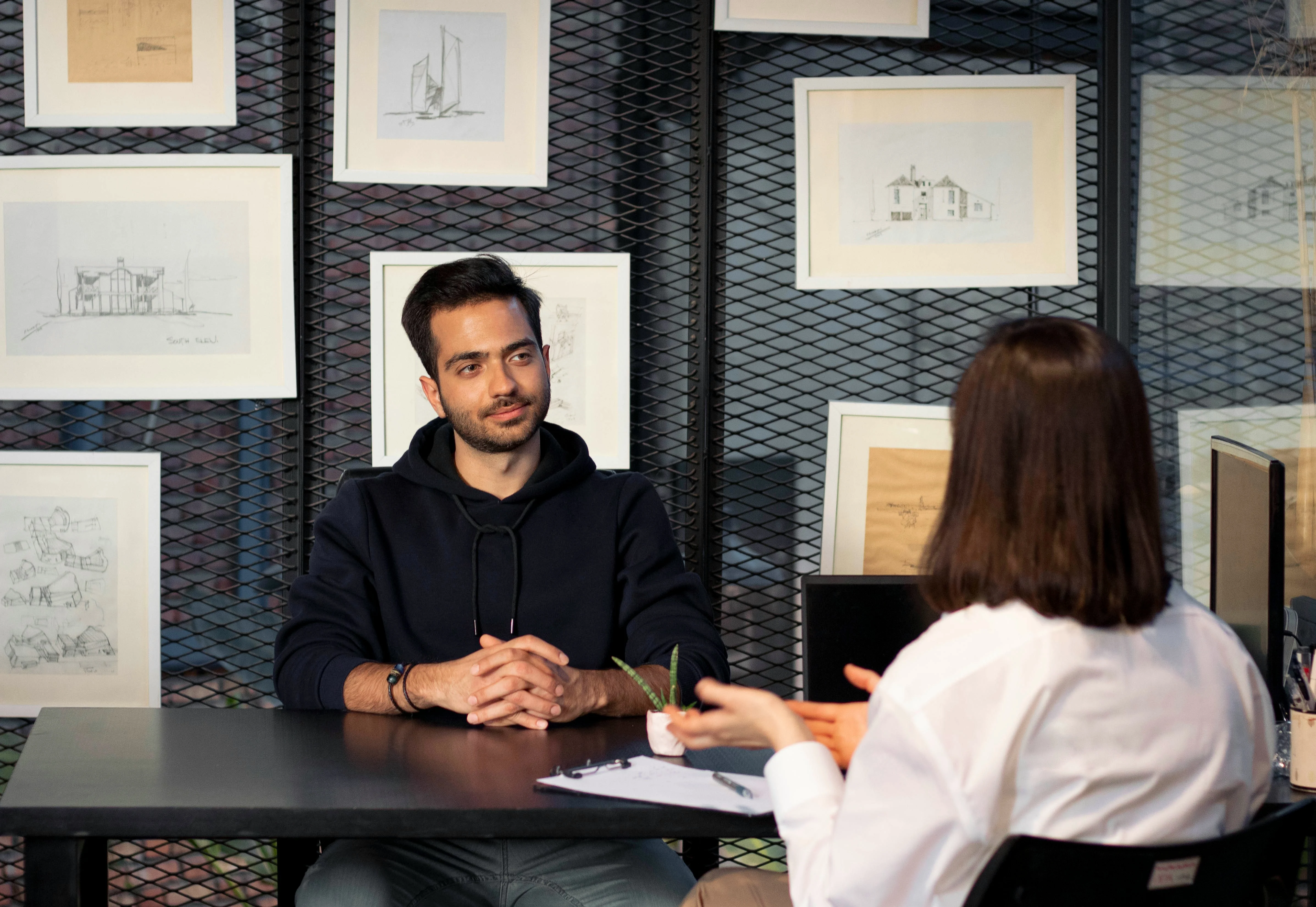
Did you know that 85% of product failures are due to a lack of user research? Yes, that’s correct. Knowing your users is not only important, it’s critical. One of the most potent weapons in your arsenal as a researcher is user interviews, which allow you to get inside the heads of your users. Mastering user interviews will pay off whether you are designing a new app, improving an existing service, or launching a marketing campaign.
In this guide, I will cover everything you need to know to run compelling user interviews in 2025. We got you from asking the right questions to interpreting responses accurately. Let’s get started.
Understanding the Importance of User Interviews
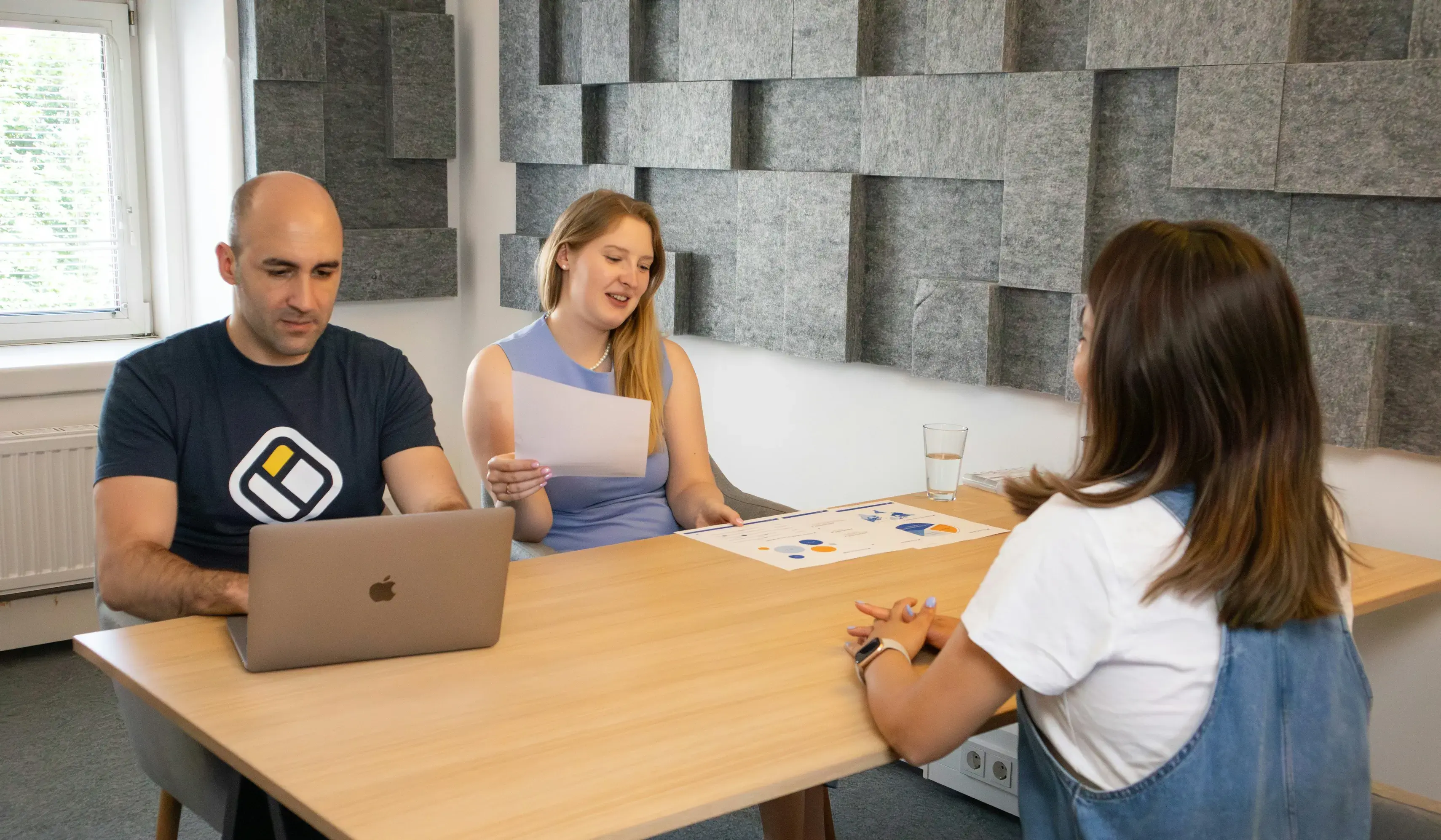
Some time ago, I was trying one of these app ideas and thought this would be the next big thing. Imagine its shiny design, intuitive interface, and bells and whistles. I mean, how could it fail? I poured my heart and soul into building it through weeks of code, late-night runs to the 7-11 to get coffee, and even some arguments with friends for goods who questioned my genius. But by the time I launched it was crickets. Not a single download.
It turns out that I made one fatal error I never actually spoke to the people I was designing for. It's not a user interview, no feedback loop, nothing. Only later did I come to appreciate how meaningful those conversations can be. And believe me, when that happens to you, you don’t forget it.
And what are user interviews, anyway? They're exactly what they sound like, conversations where you talk to users about their experiences, preferences, frustrations, and needs. But here’s the kicker, these aren’t your run-of-the-mill chit-chat. When done right, user interviews dive deep into the “why” of why someone did something or how they feel about something. You’re not merely asking, “Do you like this feature? You’re saying, “Why’d you use this feature? When do you use it? What would make it better?
Why does this matter so much? In other words, assumptions kill products. Plain and simple. You’re throwing darts with a blindfold on without knowing your audience. Yes, you might catch a bit of a bullseye by dumb luck, but most of the time, you’ll miss and spend a lot of time and money trying. We use user interviews to remove that blindfold. And they give you honest, actionable insights from the people who matter most to your users.
Here is another example from my own life. Later, licking my wounds from the app that didn’t work, I spent some time working on a project for a local nonprofit. We were redoing their website, and this time, I promised myself I’d do it differently. Before starting wireframes and color palettes, we did user interviews. One interaction that stood out was with Sarah, who said every time she tried to find volunteer opportunities, it got buried under menus. Lightbulb moment. That single insight drove the entire structure of navigation for the site. Now, fast forward six months and guess what? Pisano saw traffic to the volunteer page explode up 200%. All thanks to listening.
But here is the deal, user interviews are not only a part of tech startups or nonprofits. Writing a book, launching a podcast, selling handmade candles on Etsy you need to know your audience. These interviews can expose pain points you didn’t realize were problems. Perhaps your customers hate the packaging material you picked (true story), or maybe they wish your product was available in other sizes. Whatever it is, hearing it straight from them is better, saving you headaches later.
Now, if you’re new to this whole deal, don’t worry. Choose three to five people who embody your target audience. Start having casual conversations with them. Ask open-ended questions like, “What challenges do you face when using products like mine?” Or, “Can you explain how you last did X?” Make it conversational, not interrogative. Also, film the sessions if you can. It's much better than writing notes while desperately attempting to maintain eye contact.
Gold mines of information user interviews help bridge the gap between what you think users want and what they need. Challenge them at your own risk or embrace them and see your projects flourish.
Rehearsing for a Successful User Interview
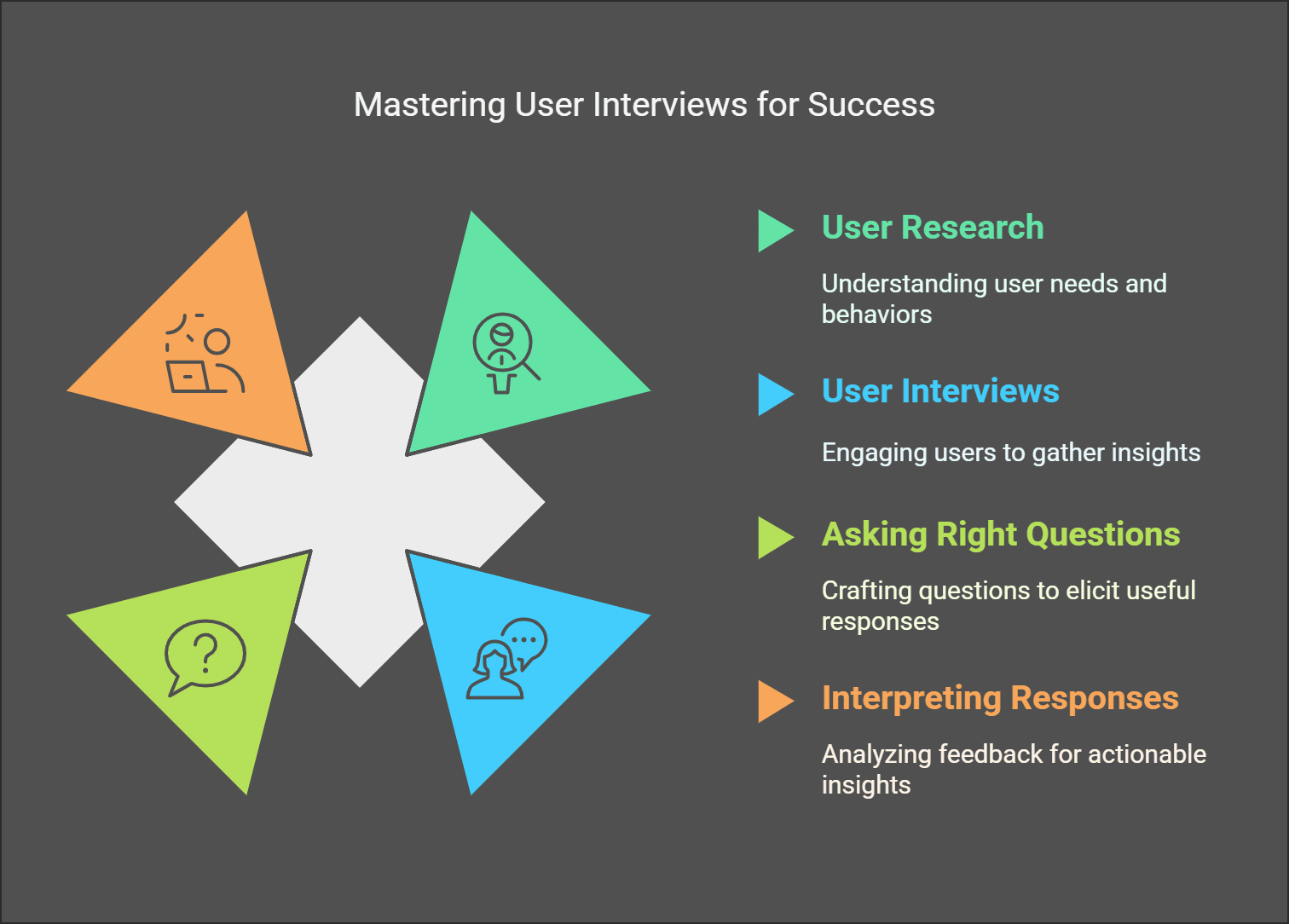
Interestingly, user interviews were once the easiest thing to do. You merely show up, ask questions, and hope for the best. I was wrong, so terrible. Let’s say my first attempt at it was a complete disaster. I could immediately tell that the user across from me was deeply disenfranchised.
On top of that, my question order did not match the flow whatsoever. So much so that I could faintly hear my phone running out of storage and my recording not being saved. It wasn't very comfortable, to say the least, but I learned that you can’t win a user interview unless you are prepared to put in the work.
Here is what I know. First things first, you must prepare or else you will fail. Would you bake a cake without gathering all of your ingredients? The same logic applies here. To start, you need to establish the reason for wanting to conduct the interview. Are you trying to figure out how a particular demographic uses your application? Or are you looking into problems that could be solutions in the next software update? Whatever it is, establishing an objective is the most crucial part. After all, having a clear vision saves a lot of trouble down the line.
After identifying your ‘why,’ focus on the right participants for your research. This isn't very easy because not everyone will provide helpful information for your needs. I remember talking to anybody who initially agreed to speak with me, which was a huge mistake. Speaking to someone not part of your target audience is as helpful as asking a vegan for burger suggestions. It’s not going to bear any fruit. Nowadays, I make it a point to write down what I need in detail. For instance, when I research a fitness application, I search for people who already track their workouts or have attempted to use such applications. Being specific is crucial.
Next comes the fun part of crafting questions. People tend to get this part poorly, either scripting every word (which is boring) or diving in entirely unprepared, leading to chaos. Having a loose framework works best. Start with broad, open-ended questions like, Tell me about the last time you struggled with [insert problem]. Then, incorporate follow-up questions based on their responses. And whatever you do, avoid leading questions like, Don’t you think this feature would make life easier? That is just fishing for compliments and will not yield honest feedback.
Logistics form the rest of the parts. If meeting remotely, ensure all technology works correctly before joining the call. Nothing kills momentum faster than spending ten minutes troubleshooting various audio problems. For in-person meetings, select a private area with very few distractions. I once interviewed at a casual coffee shop, which was a huge tactical error. Half the recording was useless between the barista yelling orders and the espresso machine screeching.
Lastly, always remember to prepare yourself mentally. Building rapport is essential. I initiate conversations with small talk. It could be asking about their day, complimenting their shirt, or anything that comes to mind. Comfort makes it easier for people to open up. One trick I swear by? Acknowledging my imperfections right off the bat. If I say, ‘I might trip over my words, but I promise, you’re going to be so helpful, that breaks the ice effectively.
It goes without saying that no, it’s not rocket science preparing for a user interview, but yes, it does require effort. Setting the goals, identifying the right people to interview, crafting thoughtful questions, and handling the logistics must be done efficiently. If you do all of that, it’s safe to say you’re walking away with gold. When I say gold, I mean insights that will be game-changing besides the data.
Developing Ideal Questions for User Interviews
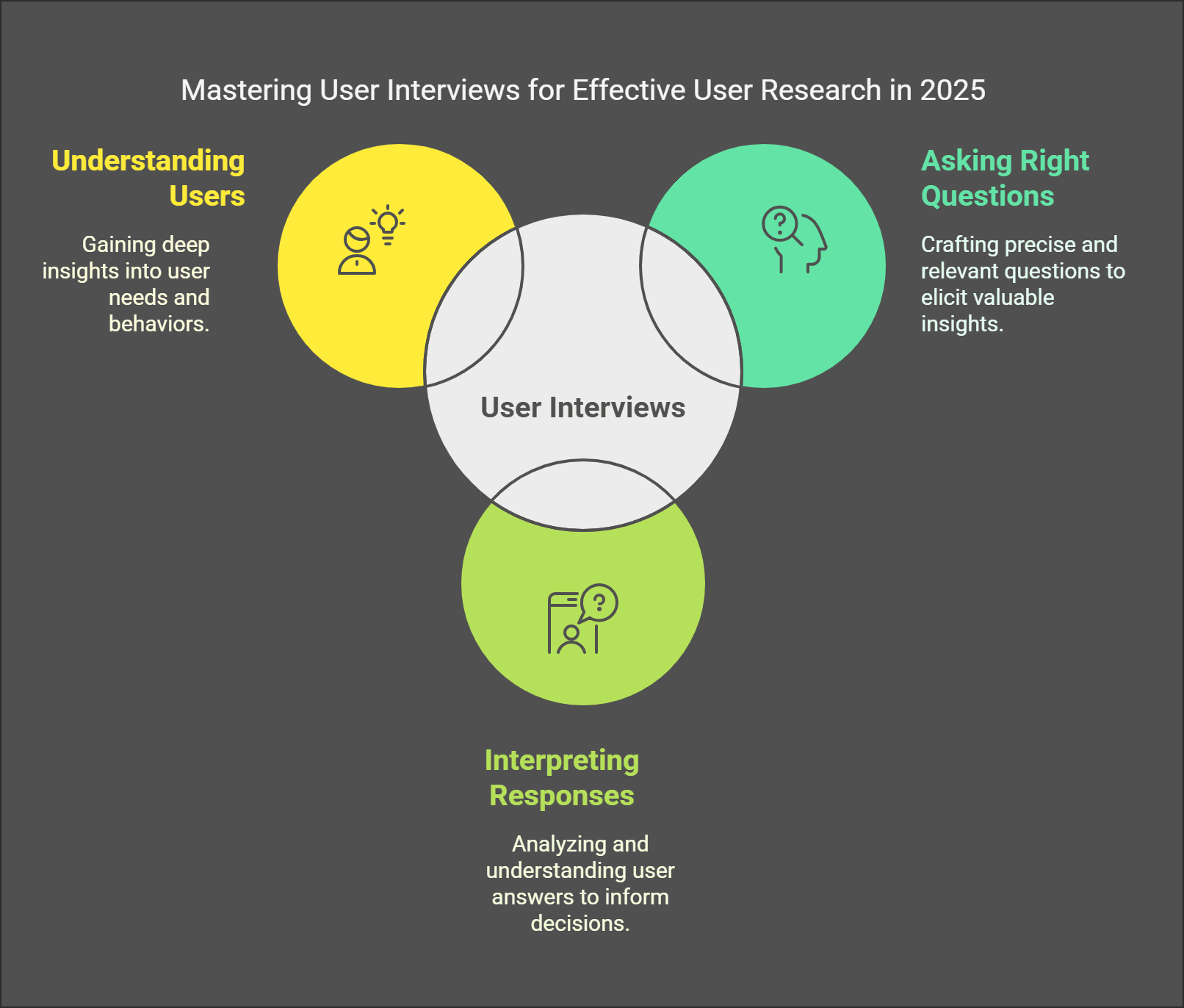
Allow me to illustrate a point. In user interviews, crafting questions with precision is akin to trying to unlock a treasure chest without the correct key. You know the valuables inside but will likely become exasperated without the appropriate key. Most people have found themselves in this situation once or twice. At the start of my career, I could figure it out as it came. How tough could it be, right? Well, it is challenging. My first few interviews were a total of failures. I made assumptions and asked what leading questions required people to answer affirmative questions I wanted instead of freely offering their real emotions. That's what I call a learning experience.
As a case in point, I was working on a project focused on a food delivery app. There was a single guy that always made my life difficult. I started with, “Isn't it the most annoying thing ever when apps take ages to load?" And to my utter disappointment, he answered yes; I was super annoyed. Wow, that is amazing. Reviewing the video, I realized I had gently led him down a path to accepting phrases he would say. At that moment, I realized how crucial it is to form well-crafted questions. It is essential, not just important.
Here’s the thing. To begin with, always use open-ended questions. These are your gold mines. Do you like using mobile apps for shopping? Which begs a yes or no answer can be flipped around to tell me about your experience with shopping apps. What stands out to you? Captured the difference? Users can share their experiences openly and are not boxed into a specific answer due to open-ended questions. Trust me; people love sharing about themselves; it’s part of our nature.
An additional lesson I’ve learned is to avoid jargon. It may seem simple, but one of the easier traps to fall into is using industry terms or lingo. I recall using the phrase “UX friction” in a particular interview with a non-technical person. They stared at me for around five seconds before saying, “Uh…what’s that?” It was quite uncomfortable.
There's a lot more to follow-up questions than meets the eye. For example, if one person mentions it felt 'clunky' to use a particular app and they could no longer use it, then you should explore that further. What exactly did you find clunky? Was it slow? Confusing? Something else. Answering those questions will give you insights that elevate the value of user interviews.
And here is a tip, Have way more questions in mind than you will actually use. I, for one, prepare around 20-25 questions, but I know I will probably only get through half. This is because conversations don’t always follow the pre-planned agenda. And that’s perfectly okay. It is fantastic because those unplanned paths lead to some of the most fascinating revelations.
Be sure to stay as informal as possible. No one wants to be interrogated. You can say, “That makes total sense,” or, “Interesting, tell me more about that.” Smiling and using positive affirmations will encourage participants to feel comfortable sharing.
Creating the right user interview questions requires practice. But the uncovered understanding is more important and in some cases, the experience will be surprising. The ultimate goal of user interviews is to gain extensive knowledge about the user base, sometimes surpassing the audience’s understanding of themselves. For such cases, prepare a notebook and start noting ideas. You will be doing yourself a favor in the future.
Conducting the User Interview

User interviews are much more complex than people believe. I still remember my first interview, and the only thing that comes to mind is how bad of a mess it was. Imagine being in the same room as someone genuinely trying to assist you, only for you to butcher your questions utterly. Every question had pauses and um’s in between, and I distinctly remember asking one of them what their most liked color was at one point, which doesn’t fit into the project. And I wasn’t even close to being done. Oh well, we all have to start from somewhere, don’t we?
With time, I learned how to conduct interviews that optimize productivity, not solely for myself as the interviewer but also for the respondents. And I can tell you without a doubt that nothing beats the feeling of coming out of an interview session knowing that you have richly earned something important. So, let me help you not make the same mistakes I did and share with you tips that I’ve learned the hard way.
First things first, building trust should be your primary focus. You wouldn’t want to undermine the participant’s comfort zone by starting with the tough questions, so begin with something casual, like asking how their day went or commenting on the weather. After the casual chat, tell them the objective of the interview using fundamental language. Make sure to highlight that there won’t be any incorrect responses. This kind of affirmation helps a lot in making individuals calmer.
And this is where people's problems usually start having too much to say. Your role isn't to speak all the time but instead listen. Active listening is when you demonstrate attention by nodding your head, making appropriate eye contact, or leaning towards the camera when remote. You also have to parrot their words to confirm understanding. For example, “What I’m hearing is that you were having a difficult time scanning for the checkout button. Is that correct?” Such phrases prove engagement but also allow them a chance to correct you if you don’t fully understand the situation.
But those dreaded silences. They do happen and can feel super awkward. In the beginning, I would attempt to fill in every gap in conversation, which, more often than not, constellated my influence on their response. What I eventually figured out is silence can be golden. Sometimes, people need a moment to reflect, and if you jump in too soon, there’s a chance you could intercept something extremely valuable. You need to give them space. And that’s perfectly fine.
What have I also picked up along the way? Avoid leading questions the same way one would avoid the plague. Instead of saying, Was the app challenging to use? Try to tell me about your experience using the app. See how the second question allows them to express themselves without being directed to a particular answer?
Here is another tip for you, record everything. Seriously, do not attempt to memorize everything or jot it down. My pen ran out of ink mid-interview once, and I lost a treasure trove of insights spanning thirty minutes. They say life teaches lessons, and that was mine, albeit the hard way. Virtual interviews on platforms like Zoom can be recorded and transcribed using apps like Otter.ai. Just remember to ask for consent, as no one enjoys being recorded without their knowledge.
As always, remember to end on a high note. Genuinely thank your participants for their time. You could also add something like, “Your feedback has been insightful, and for that, thank you,” with a lot of emphasis. Everyone loves being appreciated, and finishing with a strong note in any situation leaves a strong impact.
Looking back, I can’t help but wonder how I thought having no preparation for an interview meant I could breeze through it. You know what gives me a bit of relief and makes me happy? The fact that I can now confidently say I have leveled up. If there is one thing I wish you take away from this, let it be that professional skills can be developed quickly with preparation, patience, and practice.
Analyzing and Extracting Insights from User Interviews
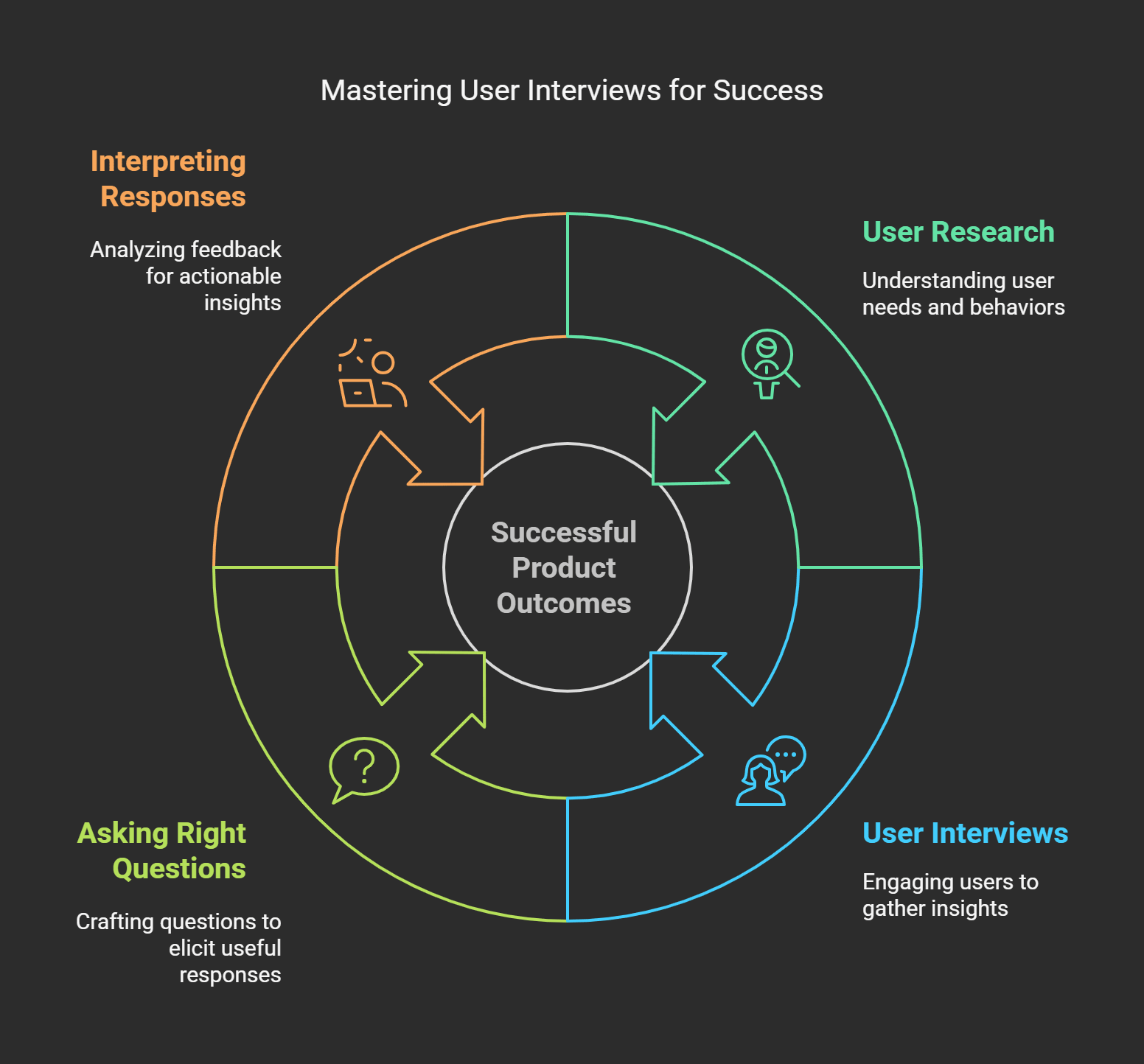
There is nothing like the feeling of finishing a round of user interviews. You take a breath and realize you have pages and recordings filled with data that need serious work. What is the next step? At that point, getting stuck tends to happen to the best of us. I know I did. For the first time, the situation looked disorganized, with no emotions and chaotic words. Rest assured, I learned some cool life hacks, but extracting insights has become a game I enjoy most as part of user research.
Starting with the first takeaway I’d give you, there is always a need to organize the data before jumping straight out to extraction; otherwise, there’ll be no benefits. It sounds very tempting; however, take it from someone who learned the lesson the hard way. In one attempt, I tried to analyze 15 interviews on the spot. After a few sticky pads, scribbling notes, and listening to recordings later, I could not figure out basic details. Always transcribe everything first. However, I had to learn by trial and error. Nowadays, platforms such as Otter.ai and Descript make life so easy.
After preparing your transcripts, it’s time to have some real fun. Read the transcripts once without making any judgments. On the second pass, mark important phrases and pain points or themes that show up multiple times. For a project I did last year, for example, almost all participants described how they struggled with too many steps involved in an app’s checkout process. We didn't expect that, but it certainly shaped our redesign priorities.
Now, that's the fun part. Combine comments that are the same into themed categories. This is called thematic analysis, and it is beneficial. For example, three people talk about wanting faster load times, which puts them in the performance issues bucket; 5 complain about unclear instructions, which puts them into the clarity gaps bucket; 2 mention poor navigation, which puts them into the usability problems bucket. Seeing patterns emerge like this? Honestly, it’s kind of magical. Tapping these themes becomes more manageable if you’re using software like NVivo or even Excel.
But don't only concentrate on the negative things. Positive feedback is just as valuable. During one of the interviews, one of the participants adored how a particular feature felt and described it as so intuitive. Initially, I thought, 'Cool, glad they enjoyed it,' and moved on. What a blunder. I learned later that the said feature had many other product parts that could be used extensively. The positive comments guide future improvements without those benefits.
What is one thing I wish someone had told me from the start? Don’t go solo. Share your findings with your team. Not every perspective may be the same, and open discussions foster teamwork. In one instance, we debated intensely for weeks over whether we should prioritize speed or aesthetics until user interview data made the decision easy.
Pro tip: Chart your data. Graphs, word clouds, and charts serve a purpose beyond just looking pretty. They allow users to understand complex information quickly. For example, a pie chart that displays 70% of users having difficulty dealing with sign-up forms will get the attention of stakeholders much faster than a paragraph ever could.
Analyzing user interviews is indeed one of the most complex procedures. I do not believe it revolves around finding the following statistic or marking the next trend. It's all about understanding people's frustrations, hopes, and needs. If done right, an individual won't merely enhance a product they will create something powerful and meaningful. People’s lives can be transformed when done correctly, and knowing that fact is one of the best feelings a person can have.
Remember to take a step back and breathe the next time you’re in interview data. You’ve got this.
Difficulties in Conducting User Interviews and Solutions
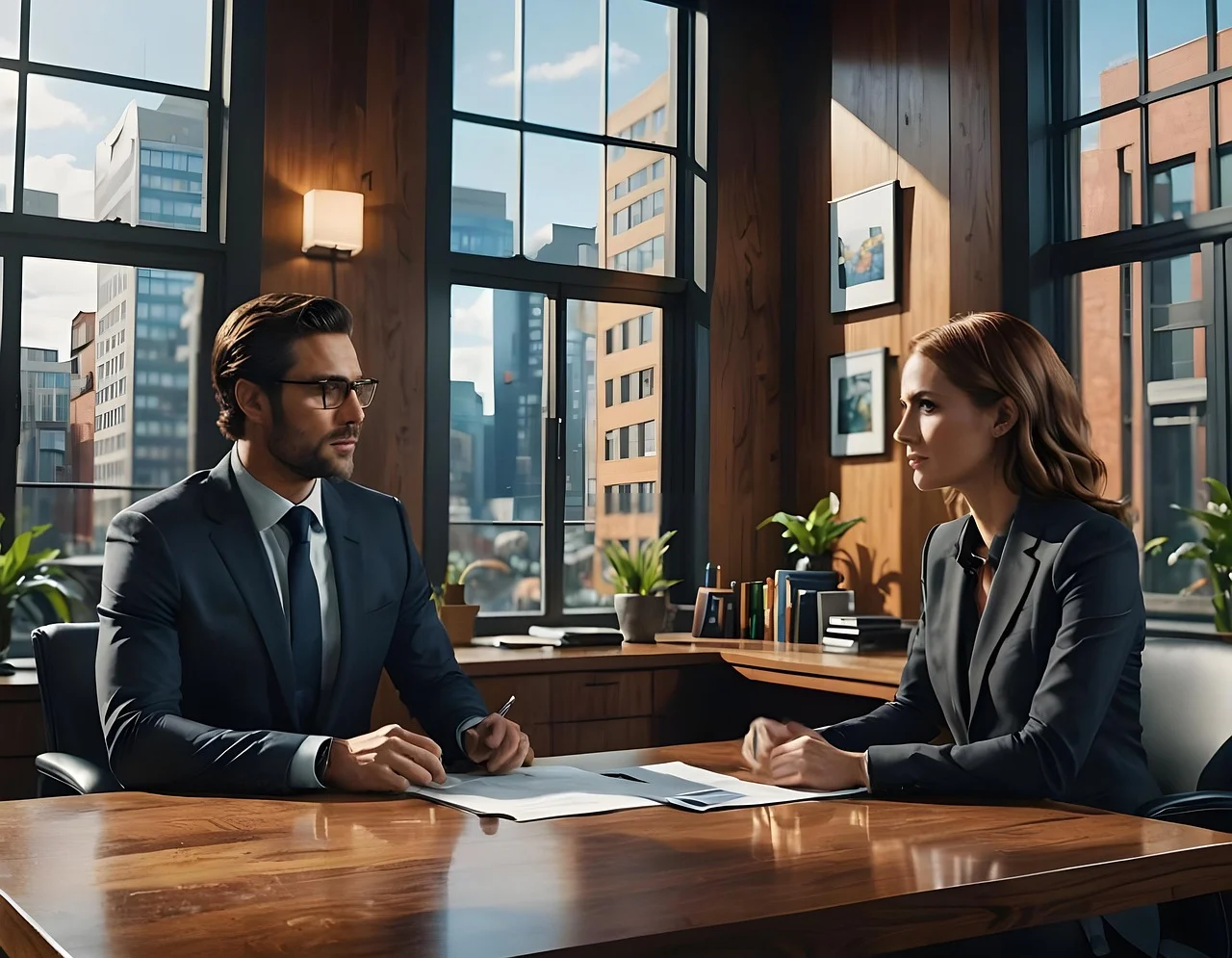
All of us know that user interviews can be a delicate process. A fine balance must be struck where one collects unique insights from users without leading them. I neutralized my bias, only to realize everything I set in place led users on a path of precognition. Awkward phrasing leaves much to be desired, but this is why we learn.
In my case, the foremost challenge was responding to vague answers. To quote a couple of examples, “Yeah, I guess it was fine,” or “I don’t really care either way.” It is very common in interviews that one has a preconceived notion about participants and their responses. These given statements were a fair reflection of my perceptions concerning the outcome and the participant's response. Answers such as those are intentional dodges. In response to the “vague” statement, my follow-ups helped put the interviewee’s assumptions on trial: “What specifically made it feel ‘fine’?” or “If you could change one thing about it, what would it be?”
And then we have the problem with pauses. This is difficult for me as well. Nothing is more annoying than asking a reasonable question and receiving complete silence. Initially, I assumed that trying to fill the silence was somehow my responsibility stepping in with a follow-up question or rewording the first one. My main point is that silence is not universally good. Participants need time to formulate ideas and reflect. Instead of rushing to fill a gap, I now attempt to relax (even if it seems strange) and allow them to process information. More often than not, they will have some fantastic insight to offer.
I have said it, and I will repeat it, we all have them, consciously or unconsciously. I remember interviewing someone for a project meant to be with users I desperately wanted to love a particular feature. What do you think went wrong? My excitement ruined the questions; the next thing I knew, the participants agreed to everything I said. What a facepalm moment. Since then, I have tried to restrain myself from using a too-warm tone and “Don’t you think this is great?” Instead, I now ask, “How did you feel about using this feature,” a lot more.
Lesson learned: You should keep your mouth shut in the presence of your opinions.
Dealing with time management is another issue. You could only have 30 minutes with a participant, and they spend the first 10 minutes talking about their cat. I am not exaggerating. To fix this, I have set clear expectations at the outset. Something straightforward like, “We have about half an hour today, and I will do my best to make sure we stay on track.” I nudge them back when they go off course by saying, “That’s awesome! Let’s go back to that we were discussing.”
Another one is that sensitive topics can be tricky. Once, I interviewed a person about their financial habits, and it became uncomfortable very quickly. They seemed to shut down almost instantly. That taught me the need to craft how the questions are framed carefully. “Why are you struggling with saving money?” was rephrased, “What tools or resources do you think might help you save better?” The difference is more solution-focused than accusing.
That said, user interviews will rarely go as planned, but every road bump is worth it. With time, having the right mindset means you will learn to navigate these hurdles and trust me, the insights you get will make the challenge worth it.
The Use of Technology in User Interviews in 2025
Hear me out. The risks of not utilizing modern technology might have the same impact as forgetting a password. Back then, I had to carry a heavy tape recorder, take notes, and record everything, which required much of my precious time. That was a nightmare. But in 2025, technology is far different in comparison. If you are still not utilizing tools that can help you make your user interviews more insightful, smoother, and faster, expect to lose in the race.
I mentioned working on a project requiring user feedback from around three continents. Considering the user's feedback, I received feedback from Screeching Continents. Taking time zone coordination as an example, it felt like solving a Rubik’s cube while blindfolded. There was some concern regarding record quality. Some had mics that sounded like they were talking using a tin can. Breathtakingly, awe-inspiringly, and mastermind-level shouting out loud annoyance. That's when I stumbled across remote work interviewing platforms such as 'Zoom (still relevant)' alongside novel tools such as Riverside.fm. These tools had myriad benefits. Automatic transcription alongside crystal clear audio blew my mind.
But wait, that isn't everything. Convenience isn't the only thing to gain. Using AI-powered tools has frequently changed the game in terms of data analysis. For example, when I recently conducted a series of interviews for a fintech app redesign, I used Otter.ai. Instead of sifting endlessly through pages of transcripts manually, I plugged the entire document into the AI tool and - voila. Highlights of key themes alongside fleet flag emotions based on tone. It doesn't take a genius to guess how much time that saves. On top of that, effortlessly gathering actionable insights instantly made my stakeholder's followers super happy.
But technology has its downsides. You’ve probably had situations where you’ve relied too much on an electronic device. For example, I had an essential interview over a video call but had to restart my Internet halfway through. I had to reconnect after the video paused for some reason. The moment I got back online, the interviewee looked as if he was going to kill me. The entire interview was out of sync. In this case, there is a lesson to take from my experience: always have alternative plans. There will not be any additional hassle when you have your phone on a limited processed internet or a notepad with a pen handy.
Even more interesting, I have started watching Virtual Reality V: headset user interviews. Walking an interviewee through a specific part of a prototype as though they’re in the space sounds intriguing. I did it once with a client who owned a retail clothing store and required some feedback on the layout of their shop. The participants could “stroll” down the aisles, grab items, and provide instant feedback on what they were picking up. In terms of methods, the amount of detail we received was unmatched. Every item on offer for expense accounts came together at a single price, and it was worth it.
And let’s spend a moment talking about inclusivity. One of the most significant achievements of modern technology is how much easier it is to accommodate a range of needs. Captions benefit people who are hard of hearing, and translation tools help with different languages. I collaborated with someone who didn’t speak English last year, and the live feature on Google Translate was a game changer. The translation is not perfect, but it is good enough to maintain the flow of conversation.
What is my recommendation? For those who are not used to interviews conducted with the aid of technology, begin with free resources like Google Meet for video calls or Microsoft Word’s dictation feature for note-taking. Familiarity with technology will allow you to expand and switch to premium options that meet your objectives. And do not forget about human interaction. Building relationships with participants will still be the most essential feature of advancing technology.
Did you know that 78% of researchers believe technological progress has enhanced their ability to gather essential insights? That’s pretty wild. Accept the coming changes but as always, anchored in reality.
Final Thoughts
The interviews with users are not simple dialogues; they reveal valuable insights regarding your customers that can fuel your creativity and accelerate your business growth. With the information in this guide, you are prepared to engage in meaningful, impactful interviews in 2025 and the following years. Don't forget that the secret to success is preparation, listening, and thoughtful evaluation.
When do you want to step up your user research? Schedule your first user interview and see how the insights gained will change how you approach your projects.




.svg)
.svg)
.svg)
.svg)
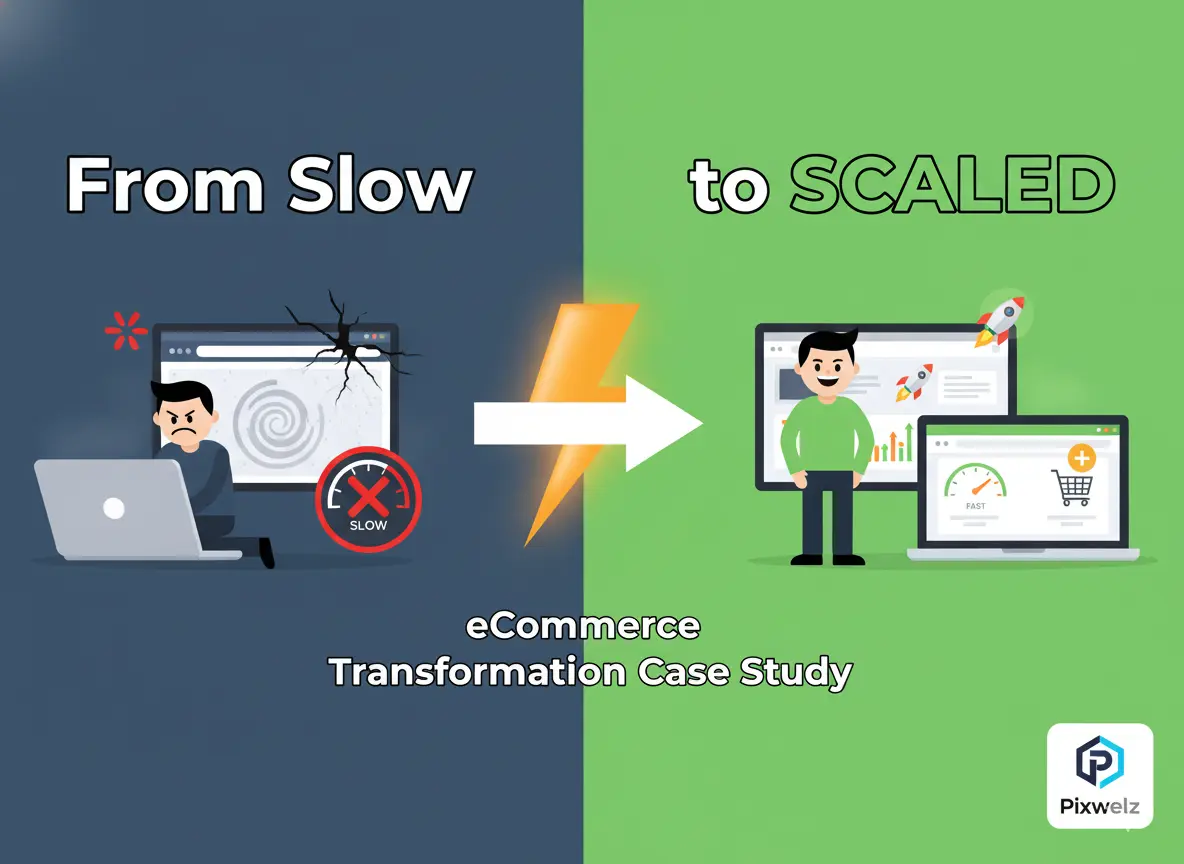
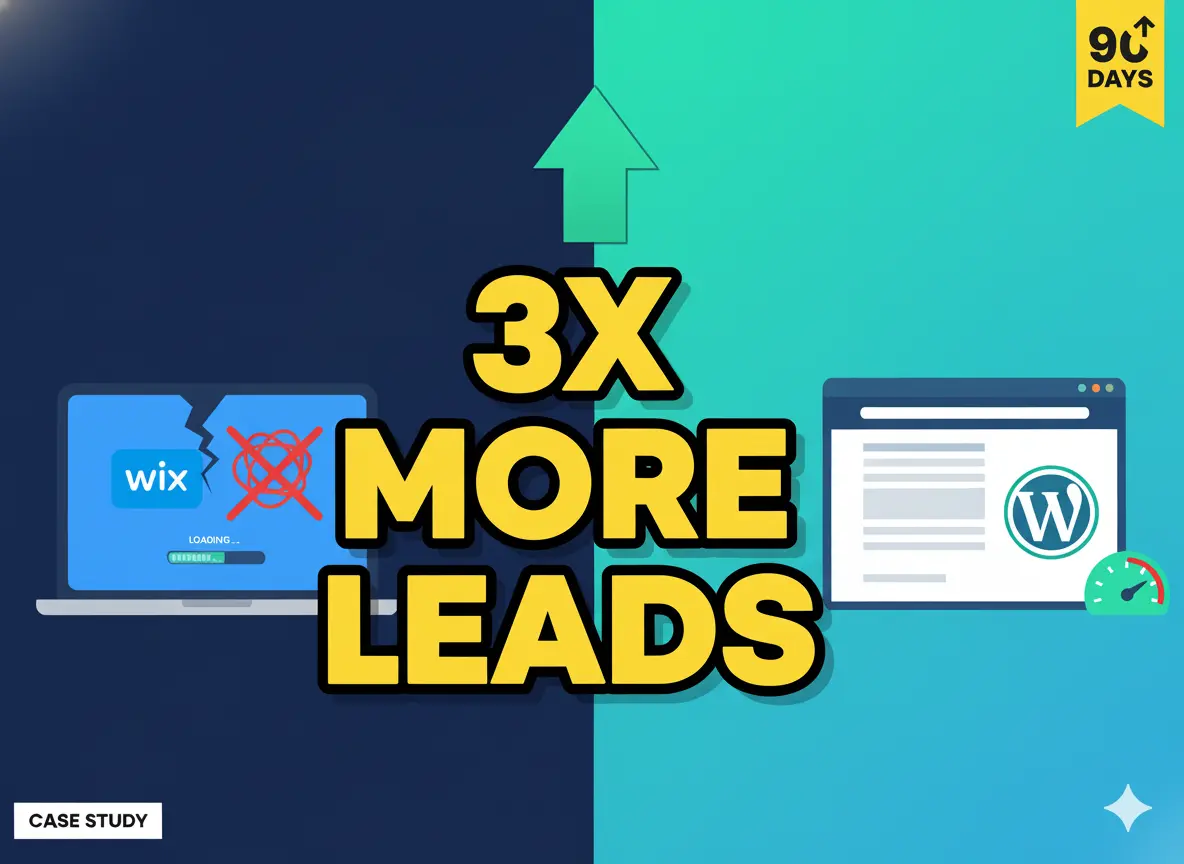
%20(1).webp)









